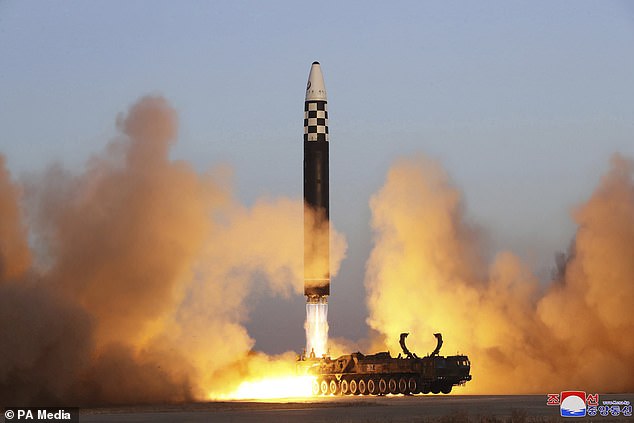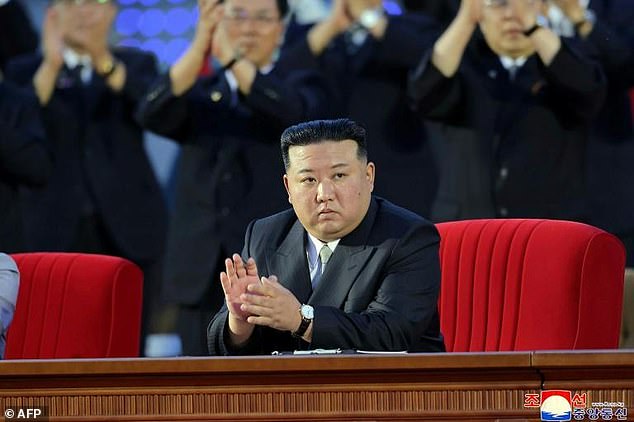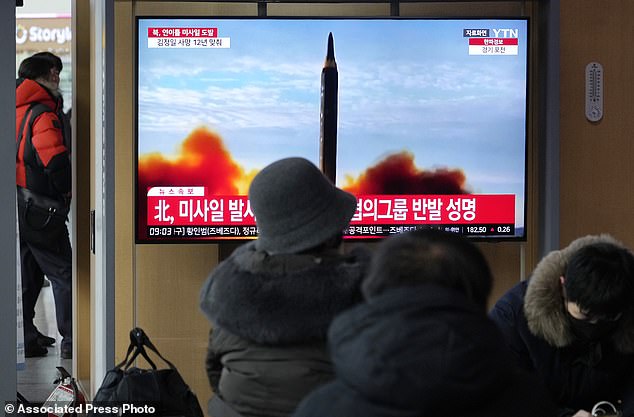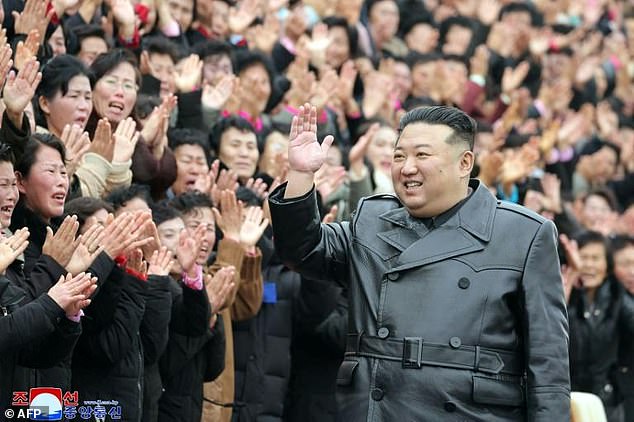North Korea fires nuclear-capable missile with range to target ENTIRE United States, Japan says
North Korea on Monday launched another long-range ballistic missile with the potential to strike the United States, Seoul and Tokyo officials said, adding to a record number of weapons tests this year.
The firing followed the test of a shorter-range missile on Sunday evening, with the successive launches immediately following a new bout of fearful rhetoric between North Korea and US-South Korean allies.
Japan's Defense Ministry said it was an ICBM-class missile with a potential range of more than 9,000 miles that could cover the entire United States.
Japanese Prime Minister Fumio Kishida described the two launches as a “threat to peace and stability,” while the US State Department was also quick to condemn them.
After North Korea fires another long-range missile, a woman in Seoul walks past a television screen showing a news broadcast showing file footage of an earlier missile test

An ICBM during a launch exercise at Sunan International Airport in Pyongyang, North Korea (file)
“These launches, like other ballistic missile launches conducted by Pyongyang this year, violate multiple United Nations Security Council resolutions,” the US State Department said in a statement.
South Korea's military said it had detected the launch of a long-range ballistic missile from the Pyongyang area on Monday morning, which flew 620 miles before crashing into the East Sea, also known as the Sea of Japan.
The South reported that the missile flew upwards instead of across, a method Pyongyang previously said it used in some weapons tests to avoid flying over neighboring countries.
The United Nations Security Council has passed many resolutions since its first nuclear test in 2006 calling on North Korea to halt its nuclear and ballistic missile programs.

North Korean leader Kim Jong Un has overseen a record number of weapons tests this year that have been condemned by the West.

North Korea fired an intercontinental ballistic missile into the sea on Monday as it resumed its high-profile weapons-testing activities, its neighbors said, as the North vowed strong responses to US and South Korean moves to strengthen their nuclear deterrent plans.
North Korea has already tested four ICBMs this year. It first launched the Hwasong-18 – the most advanced and powerful ICBM – in April and then again in July.
The Hwasong-18 is North Korea's first ICBM to use solid fuel, making it easier to transport and faster to launch than liquid-fueled versions.
The spokesman for South Korea's Joint Chiefs of Staff said they were analyzing whether Monday's launch was a solid-fuel ICBM.
Park Won-gon, professor of North Korean studies at Ewha University, said there was a good chance Pyongyang would test a Hwasong-18.
“The Hwasong-18 uses solid fuel, so there is no preparation time, and it can be fired instantly from a mobile launcher, and it can be viewed as a weapon system with a practical ability to hit the U.S. mainland,” Park explained. .

The Hwasong-18 is North Korea's first ICBM to use solid fuel, making it easier to transport and faster to launch than liquid-fueled versions
North Korea declared itself an “irreversible” nuclear power last year and has repeatedly said it will never give up its nuclear program, which the regime says is essential to its survival.
The United States and South Korea held their second session of the Nuclear Consultative Group in Washington on Friday, discussing nuclear deterrence in the event of a conflict with the North.
On Saturday they warned that any nuclear attack from Pyongyang on the United States and South Korea would result in the end of the North Korean regime.
A North Korean Defense Ministry spokesman on Sunday denounced allied plans to expand the annual joint military exercise with a nuclear operations exercise next year.
“This is an open declaration of nuclear confrontation to make the use of nuclear weapons against the DPRK a fait accompli,” said a statement from news agency KCNA, using the official acronym for North Korea.

North Korea's missile launch came as the country marks the birthday of leader Kim Jong Un's father and predecessor Kim Jong Il
“Any attempt to deploy forces against the DPRK will face a preemptive and lethal counteraction,” it added.
The North's launch of its military spy satellite last month has further damaged ties.
The North portrayed it as a major breakthrough, claiming it provided images of U.S. and South Korean military sites.
That launch broke a military agreement between the Koreas that had been struck to de-escalate tensions on the peninsula.
After the launch of the spy satellites, both sides increased security along the demilitarized zone (DMZ) that separated them.
“If North Korea does something reckless that destroys peace, they will only face a hell of destruction,” South Korean Defense Minister Shin Won-sik warned last week during a meeting with top military commanders.
KCNA also quoted North Korean leader Kim Jong Un as saying his military had “eyes that looked out over a very long distance and had a strong fist that punched over a very long distance.”
Professor Park of Ewha University said the 'fist' referred to the Hwasong-18.
